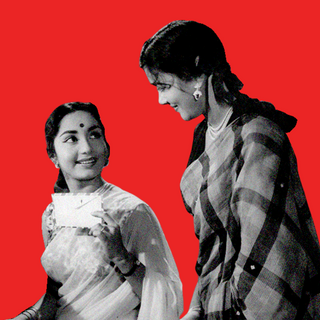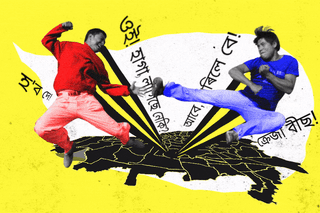
How a Home‑Made Kung Fu Movie Captured Guwahati’s Imagination
Local Kung Fu offered audiences a fresh style of filmmaking. Nine years down, the film continues to engage and entertain in Assam.

A Guwahati man, speaking on the phone, steps out of his car on a winter afternoon. A speeding bike barely misses him, his necktie and coat fly for a moment. He yells at the rider, already miles away: Oi! Haga lagise neki? Oi! (loosely translated: Hey! Do you badly need to take a dump?)
When Mahesh Deori spoke these lines on camera at a relative’s request, he had no idea that, in a few months’ time, it would become a mainstay of Guwahati’s youth culture. The film in which it appeared, Local Kung Fu, also went on to mark a watershed moment in Assamese entertainment.
In a state where film-making is starved of both institutional support and audience enthusiasm, an unassuming home-made film occupies a permanent spot in people’s imaginations, influencing speech, mannerisms, conversations – and the idea of entertainment itself.
Made on a budget of less than one lakh rupees, Local Kung Fu released in theaters nine Septembers ago. It stayed on screen for a bare total of five days before an early release of Ranbir Kapoor-starrer Besharam pushed it out of theaters. Despite its short-lived release, about a year later, the film’s dialogues, mannerisms, and characters had all achieved cult status, especially among the youth of Guwahati.
“Discussions among friends in school, between classes and during bus rides, often used to revolve around specific scenes and dialogues from the movie,” recounts Raghu Pratap, an independent filmmaker and writer who grew up in the city.
Adhiraj Kashyap, another independent filmmaker from Assam who is currently studying at the Film and Television Institute of India (FTII), Pune, narrates one incident illustrating the film’s popularity from when he was in school. “I was unaware about the film then – I only watched it a few years after. But I saw another guy… fawn over [one of the film’s actors] like a fanboy. The ‘Number One Under-18 Don’ was already famous,” he says, referencing a character from the film.
Related on The Swaddle:
What the Loss of Movie Theaters Means for a Culture
Local Kung Fu was directed by Kenny Deori Basumatary, now a successful filmmaker and actor with his own trademark style. Back then, however, Basumatary was an IIT Delhi drop-out who was experimenting with his filmmaking technique by making short films and music videos on his YouTube channel. When he saw people approaching his uncle, a martial arts instructor, for advice on filming fight scenes, Basumatary decided to combine his love for action, comedy, and his flair for filmmaking. With this confidence, and about Rs. 1,00,000 from his ex-civil servant mother, Basumatary set out to buy a DSLR and write a script around Kung Fu. He cast his relatives and friends, a lot of whom were his uncle’s students.
All these things helped ground Local Kung Fu to its context and bring a freshness and novelty that made the youth of Guwahati connect instantly with it. “When we were writing the script, we decided to not use the flowery language that was the norm in the movies here, and instead chose to keep things conversational,” Basumatary tells me over a phone call. The use of regular Guwahati-speak, at times grammatically inaccurate and peppered with Hindi phrases, helped set the film in a cultural milieu that was instantly recognizable and relatable.
The film’s depiction of Guwahati – it begins with a montage of iconic landmarks of the city – spoke to its youth. The plot centers on a set of young people and some of their middle-aged relatives. Barring one cameo, there is not a single character in the film who’s old. Pratap believes that Local Kung Fu inadvertently documents what it is like for a young person to live in Guwahati.
“Going out in the evening to eat momo with friends, love for pork, young adults drinking alcohol and chewing sikhor (the Gutkha brand), unruly boys moving in gangs perpetually on the lookout for a jeng (a local word for picking a fight) – these were all things that we knew about and spoke about but had never seen depicted on screen before.”
Kashyap echoes this sentiment and goes on to explain the larger cultural context that made the film connect so instantly. “Just a little while before Local Kung Fu came up, mainstream Indian cinema was seeing a sort of rejig. Filmmakers like Anurag Kashyap, Vikramaditya Motwane, and Dibakar Banerjee were setting the scene, moving away from narrating larger-than-life NRI stories. People were warming up to celebrating stories that were local. A year before Local Kung Fu, Anurag Kashyap released Gangs of Wasseypur. That changed a lot of things.”
Kashyap also opines that the various ridiculous characters and unique events that the film is laden with stayed with the audience long after the film ended. These include a local goon and his friends seeking a liquor license, a character forging his identity to his “Malayali-Assamese mix” girlfriend’s local guardians to win them over, a notorious naked thief who allegedly roams around the city with oil rubbed on his skin, a Tansen who is equally adept at singing and fighting, and a scene involving a discussion on how snails and silkworms taste.
But beyond the idiosyncrasies and relatability and even the action, there lies another story behind the success of Local Kung Fu in a state where most people do not watch films. “Only fifty [cinema] halls,” Basumatary explains. People rely on other mediums for entertainment, such as mobile or traveling mass theaters telling stories with song and dance, and “VCD films,” which are direct-to-video masala movies. Those who do go to the theater prefer going for Hindi or English films.
Local Kung Fu thus reached the masses not through its limited lifespan in a movie hall but through piracy and pen drives. Kashyap tells me that the first time he watched Local Kung Fu was on a friend’s computer. Pratap too has a similar story. Piracy ultimately complemented the viewing experience of the movie. Part of Local Kung Fu’s charm came from its low-budget, home-video aesthetic. “The home-video aesthetic really makes the film feel truly local,” Pratap opines.
The film came out in late 2013, a time when very few people owned a computer, and even fewer had access to the internet to seamlessly stream videos in HD. Smartphones were still not the norm.
“Watching a low definition, home-video-style film on your device thus felt like a very familiar and personal experience. I or people I know didn’t think of it as a feature film while watching it, which took away the expectations one would usually keep from cinema,” Kashyap explains.
Basumatary recounts how the film managed to fall into so many unauthorized hands. The first copy was made even before the film was officially released. “We had given the film to a local TV channel. The person who was tasked with keeping it safe watched it, loved it, and ended up making a copy of it on his pen drive. He then showed it to a couple of his friends, who then insisted on taking the movie with them. And the cycle continued.” Sometime after Local Kung Fu left the screens, a dejected Basumatary went back to work in Bombay. When he returned a year and a half later, he discovered that the film had spread like a pyramid scheme among school and college students.
Related on The Swaddle:
How the ‘Pan‑India’ Movie Phenomenon Embodies — And Redefines — Toxic Masculinity
In this ironic incident of a TV channel worker — expected to be responsible for keeping movies safe –pirating the film and spreading it, lies a paradox that grips Assamese cinema today. Cinema can only be commercially viable if there are people to watch it, but very few people will go to a theater to watch an Assamese movie unless they know for sure that it’s good. Plus, distributors and hall-owners are much keener to screen a big-budget studio film from Bombay or Hyderabad or America since they promise larger returns than films made in Assamese.
To combat the lack of funding, filmmakers have often tried relying on crowdfunding to meet production costs. Basumatary did this for his projects that followed Local Kung Fu, including his latest, Local Utpaat, whichcame to theaters earlier this year and ran successfully for 13 weeks. However, crowdfunding can only work if a film promises to play to the crowd to an extent. And this comes across in Local Utpaat’s production.
Although the film suffers from various technical flaws – the sound is inconsistent, the plot elements borrow heavily from existing sketches on Heavy Budget(a YouTube channel run by Basumatary’s brother and cousins, employing a similar aesthetic to Local Kung Fu), and the filmmakers place greater emphasis on staying true to the “local” tone and aesthetic than the performances – it works commercially because it delivers exactly what people were expecting in a film by Basumatary.
“The Local Kung Fu aesthetic has now become a brand, so other content creators and filmmakers are trying to copy it, trying to cash in on its popularity,” Kashyap says.
“It is a dangerous trend, for it will saturate the audiences with homogenous content and stunt original thought. Also, eventually, the audience will be so bored by this saturation that they will even stop watching films made by Kenny himself.”
Local Kung Fu’s raging cult-ish success, then, has led to many forsaking creativity or originality in favor of relatability and familiarity of content to gain popularity and short-term commercial viability.
Towards the end of my conversation with him, Basumatary lets on that he wants to make “every genre, every kind of film.” However, he also acknowledges that those films might not work well with the audience or the Box Office, and that he will soon start working on Local Kung Fu 3 to satisfy audiences.
Anurag Kashyap often looks back at the success of Gangs of Wasseypur in regret. In an interview with LiveMint this year, on the film’s 10-year anniversary, he explains, “People keep expecting me to make the same film. It has derailed me in a way. Everything I do is compared to that.”
Amlan Sarkar is a staff writer at TheSwaddle. He writes about the intersection between pop culture and politics. You can reach him on Instagram @amlansarkr.
Related


The Buzz Cut: Human Allies Stand Up for Mermaid Community Alleging Inaccurate Representation
